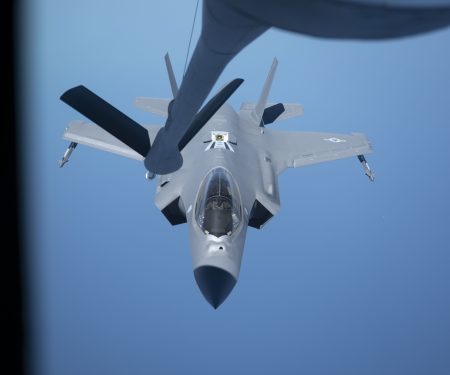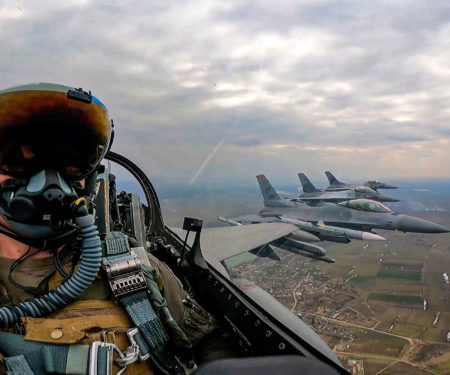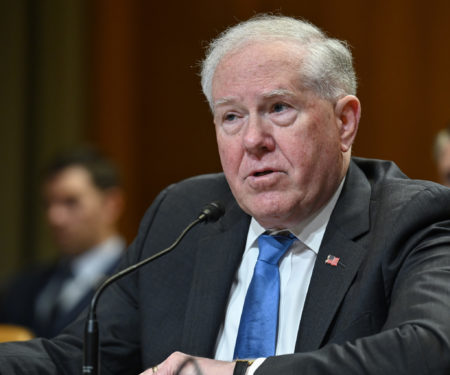Pentagon: No ‘Drop’ in Iran Threat to Ships, As F-35s and Harriers Keep Flying over the Gulf
Lockheed to Set Up European F-16 Schoolhouse That May Eventually Train Ukrainians
Hurricane Idalia Battered Florida Bases, But Damage Is Contained
Kendall: USAF ‘Not as Ready as We Need to Be’ for China Challenge
Outstanding Airmen of the Year: Tech. Sgt. Micaela R. Mahan
Radar Sweep
Zelenskyy Says Ukraine Has Developed a Long-Range Weapon, a Day After a Strike Deep Inside Russia
Ukrainian President Volodymyr Zelenskyy said Aug. 31 his country has developed a weapon that hit a target 700 kilometers (400 miles) away, in an apparent reference to the previous day’s strike on an airport in western Russia. Zelenskyy said on his Telegram channel the weapon was produced by Ukraine’s Ministry of Strategic Industries but gave no other details.
Japan Unveils Defense Budget, Seeking Hypersonics, Frigates, F-35s
Japan’s Defense Ministry has requested another record defense budget, with the agenda featuring naval vessels, F-35 fighter jets, hypersonic weapons development, and armored vehicles. The ministry announced Aug. 31 that it submitted a request for $52.9 billion to the Finance Ministry for the coming fiscal year, which starts April 1, 2024.
Go Deeper on Operational Imperatives
Virtually every part of the Department of the Air Force’s drive to modernize is being shaped by Secretary Frank Kendall’s seven Operational Imperatives—lines of effort that address the most important and urgent challenges facing the Air Force today. Now, the department and industry are working together to develop solutions for each imperative, and the results will likely change the Air Force and Space Force for the next generation. Keep up with all the latest news on each Operational Imperative.
Troops: Check New ‘Use It Or Lose It’ Rules to Avoid Forfeiting Leave
Troops who have accumulated more than 90 days of leave should check their balances to see if they need to use some of it by the end of the fiscal year, Sept. 30. Defense officials have changed the rules about carrying leave over from year to year, based on a change in law.
A Year after China Cut Mil-to-Mil Contacts with US, a Hint of Thaw?
U.S. Indo-Pacific commander Adm. John Aquilino spoke with Chinese defense officials at a conference this month, a potential breakthrough in military-to-military communications more than a year after China suspended most such interactions. When Air Force Brig. Gen. Pat Ryder was asked on Thursday to respond to a Chinese defense ministry spokesman’s comments about communication between the two militaries, the Pentagon press secretary cited Aquilino’s meeting as an example of U.S. willingness to keep avenues of communication open.
Norms Plus Counterspace Weapons: RAND Recommends Holistic Strategy to Deter Space Attack
While it likely will be impossible to completely deter adversary attacks on U.S. space systems, a strategy that takes a mixed approach—including diplomacy at one end and offensive counterspace weapons at the other—is most likely to be successful, a new RAND Corporation study finds.
SILENTBARKER ‘Watchdog’ to Be ‘Exponential’ Leap in DOD Monitoring of Chinese, Russian Sats
The Defense Department’s next-generation, classified space monitoring constellation, called SILENTBARKER, will provide an “exponential” leap in America’s current capability to keep tabs on potentially threatening Russian and Chinese satellites once it reaches full operational capability in 2026, according to senior officials. Jointly developed by the National Reconnaissance Office (NRO) and the Space Force, SILENTBARKER will be a “watchdog” in geosynchronous Earth orbit (GEO), NRO Director Chris Scolese said in a press conference on Aug. 28.
Air Force Releases BAA on Artificial Intelligence for Next-Gen Command and Control
The Department of the Air Force released a broad agency announcement on Aug. 31 covering eight technical areas related to AI and new capabilities for distributed command and control. About $99 million in total funding has been allotted, with most individual awards expected to range from $200,000 to $20 million, according to the BAA.
US Air Force Selects Fast Microreactor for Nuclear Power Pilot
The U.S. Air Force’s first nuclear microreactor planned for Eielson Air Force Base in Alaska under a federal nuclear microreactor pilot program will be an Oklo liquid metal-cooled fast reactor. The Defense of Logistics Agency (DLA), acting on behalf of the Department of Air Force (DAF), on Aug. 31 issued a Notice of Intent to Award (NOITA) that selects the Santa Clara, Calif.–based nuclear technology firm Aurora Powerhouse for its Eielson Air Force Base pilot and initiates an acquisition process to potentially award Oklo a 30-year, firm-fixed-price contract to pilot the advanced nuclear energy technology.
Pentagon Launches ‘One-Stop Shop’ for Declassified Info on UFOs
The Defense Department on Aug. 31 unveiled a website that's intended to serve as a clearinghouse for declassified information on unidentified aerial phenomena. The site is being billed as a "one-stop shop" for publicly available records on UFOs, and is expected to shed light on the work of an office created by Congress last year that coordinates efforts across federal agencies in detecting and identifying what the Pentagon officially refers to as unidentified anomalous phenomena, or UAPs.
This ICBM-Launched Satellite Could Transmit Nuclear Codes When Nothing Else Was Left To
During the Cold War, the U.S. became concerned with the question of how it could initiate the launch of intercontinental ballistic missiles (ICBM) and nuclear-armed bomber strikes should its land-based and airborne command and control systems be destroyed during a nuclear attack. The AN/DRC-8 Emergency Rocket Communications System (ERCS) was the solution.






